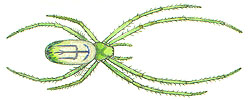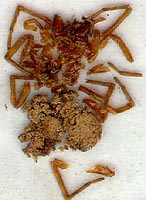 |
|
| You Are Here: Burke Museum : Spider Myths : I.D. : Spiders by Mail |
Myths about Identifying Spiders
 |
|
Pulverized: a spider mailed loose in an
envelope of any kind is liable to look like
this when it arrives. Scanned from specimen. |
Myth: Spider specimens submitted for identification can be mailed like a letter in a common envelope.
Fact: Believe it or not,
people actually do this. A little reflection should lead anyone to realize that
letters in envelopes, even padded or cardboard ones, go through heavy-duty canceling
machines in the post office, and any spider that is not protected in a rigid
box or bottle will be crushed to powder. Powdered spiders are seldom identifiable!
It is best to preserve spiders in a non-leaky container of rubbing alcohol before
they have dried out. (Do not use formalin, which is not a preservative for spiders).
Dried spiders are far from ideal for identification purposes, but in case of
need they should be packed with soft tissue paper (so they won't rattle around)
in a rigid box or other container.
 |
Properly-preserved spider in well-sealed vial of 70% alcohol. Note enclosed label giving exact site & date of collection! |
Myth: When trying to identify a spider, the only possibilities are species you've already heard of.
Fact: This seems to be the unspoken assumption
when people try to make any spider they find fit the descriptions of one of
the 2 or 3 widely publicized medically-important species. These people are forgetting
that there is much more to the world than the parts familiar to them. Only biologists
seem to realize that most land areas of any size are home to, not several spider
species, but several hundred -- most of which are seldom noticed by the
human population.
These days, those working with biodiversity constantly have their noses rubbed
in the fact that even species known to biologists are only the "tip of
the iceberg" compared to the number likely existing in under-sampled habitats.
It would not be too surprising if the 50,000 or so spider species named to date
were only 10% of the total. So don't make any assumptions about your spider
specimen; unless you're an arachnologist, you've likely never heard of the species.
This goes, likewise, for spiders you're able to find pictures of. Remember there
are thousands of other species that have no photos available. The pictured ones
are not the only possibilities!
| Previous Myth | Myths Home | Web Resources | Next Myth |
 |
Text ©
2003, Burke Museum of Natural History & Culture, University of Washington, Box 353010, Seattle, WA 98195, USA Phone: 206-543-5590 Photos © as credited |
Queries
to Spider Myths author, Rod Crawford This page last updated 2 September, 2010 This site best viewed at 800 x 600 using IE 5.0 or above. |